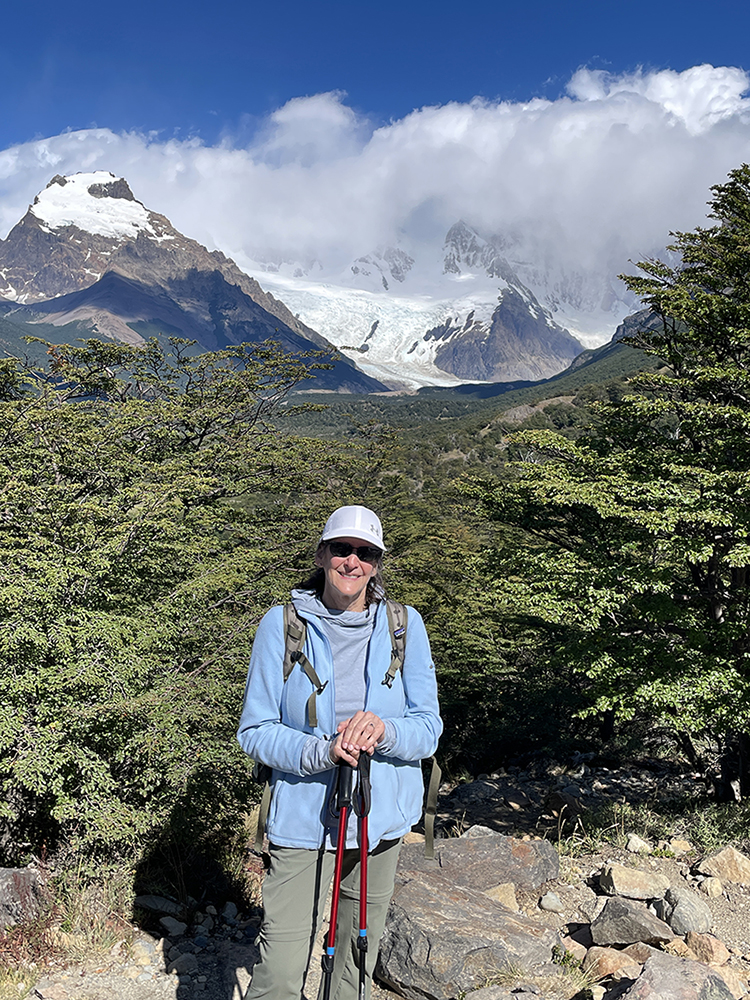
Joan DeFeis has lived a life rich with varied careers and travel adventures. Her early career saw her as an Assistant Dean of Students at Boston College, but her adaptability and passion for learning new skills, such as computer design in the mid-80s, allowed her to stay at home with her young son while launching a freelance graphic design business. Later, she applied her computer skills as an Instructional Technology Specialist in the Boston public schools, where she spent the final years of her teaching career as an English as a Second Language (ESL) teacher and coordinator.
Joan’s life took an unexpected turn when in 2017, a seemingly routine gardening incident led to a life-changing diagnosis. While attempting to pull out a large, deeply rooted weed, she felt a pop in her side. Thinking she had broken a rib, she rushed to her local health care center. An X-ray determined there was not a broken rib; she had most likely torn a ligament. However, the X-ray revealed a shadow on her lung. Initially dismissing it, the doctor told her not to worry, as shadows are common on X-rays, which a physician friend confirmed. A follow-up chest X-ray in one month was recommended. As a result of their lack of concern, Joan didn’t think much of the shadow and did not go back for the chest X-ray until several months later. This time, the shadow was still there, but upon further inspection, they discovered yet another shadow in a different lobe. Further tests, including a CT scan and a biopsy, confirmed the suspicious shadows were lung cancer. She never smoked and has always maintained a healthy lifestyle, which made her diagnosis a shock to her and those who know to her.
Joan sought a second opinion at Dana-Farber Brigham Cancer Center where she was diagnosed with stage III lung adenocarcinoma. Adenocarcinoma affects both smokers and non-smokers. This is a slow growing cancer that usually starts in the outer areas of the lung, specifically in the mucus-producing cells lining the small airways, called bronchioles. Trusting Dana-Farber Brigham’s world-renowned expertise, Joan began her treatment with a multidisciplinary team, including Daniel Wiener, MD, a thoracic surgeon at Brigham and Women’s Hospital who specializes in lung cancer surgery. “Why go somewhere else when you have the best cancer center at your fingertips?” Joan said of her confidence in Dana-Farber Brigham.
Soon after, in February 2018, Joan underwent a pneumonectomy, where her entire right lung was removed. This was due to two tumors located in both the upper and lower lobes of her right lung connected by a string of cancerous cells through the middle lobe. At a previous hospital where Joan had initially sought help, a more invasive surgery was planned where traditionally the surgeon would make a large incision on her side and spread open the rib cage to access the lungs. But at the Brigham, Dr. Wiener opted for a minimally invasive procedure called Video-Assisted Thoracoscopic Surgery (VATS) to accomplish the same goal. This approach involved only three small incisions instead of a large one, without needing to spread the ribs, thereby significantly reducing her recovery time.
“While minimally invasive pneumonectomies are rare due to the size and spread of most tumors, there are exceptions,” said Dr. Wiener. “For instance, in Joan’s case, her tumor spread across two lobes but was not particularly large, allowing for a minimally invasive procedure.”
In 2018, during Joan’s VATS surgery, this method was considered pioneering for a pneumonectomy. While minimally invasive pneumonectomies are still rare, this approach has become common for more standard resections. Today, for example, approximately 60 percent to 80 percent of lung resections are performed using either VATS or robotic methods.
"Since the time of her surgery years ago, I have primarily replaced VATS with robotic surgery, but both are now standard minimally invasive approaches,” said Dr. Wiener. “We continuously innovate and refine our surgical methods to ease the patient experience while making sure we are still treating the cancer optimally. We collaborate with colleagues in medical and radiation oncology and provide the best possible surgery as part of a comprehensive treatment plan that often involves multiple specialties. Minimally invasive approaches are always considered for patients with lung cancer, though there might be some cases when this is not possible.”
Back in the recovery unit, Joan was walking the day after her surgery, evidence of the advanced technique's success. After surgery, Joan required four rounds of chemotherapy given the stage of her cancer. She recalls the chemo as the most challenging part of her recovery, leaving her exhausted and barely able to walk. Yet, this rigorous treatment regimen, combined with the successful surgery, has left her cancer-free more than six years later.
"I had cancer, but cancer never had me,” Joan said. “I do my best to apply a positive attitude to my life. I truly believe a positive frame of mind helped immensely with my recovery. It encourages me to undertake new challenges with a ‘can-do’ attitude every day.”
Despite losing her right lung, Joan has not let it hinder her zest for life and adventure. She continues to travel extensively, having recently explored Patagonia, Antarctica, Zion National Park and Bryce Canyon National Park, where she hiked at elevations over 9,000 feet.
Before her cancer treatment, she had also walked the historic Camino de Santiago twice, starting from France and Portugal. This fall she plans to embark on the “Camino Ingles,” a shorter —although still impressive— 75-mile route, and travel to New Zealand this coming winter, a trip she originally postponed due to her diagnosis.
Amidst travel adventures and volunteer projects, Joan is currently working on a children’s book detailing her cancer journey, aiming to provide hope and understanding to young readers facing similar challenges. She continues to follow up annually with her thoracic surgeon at Brigham and Women’s Hospital for surveillance, where she and Dr. Wiener exchange images: a reassuring CT scan and photos of her life’s adventures.

Joan in Patagonia near Monte Fitz Roy (pictured above). Joan and her son, Luke, at Machu Picchu after hiking the Inca Trail (left). Joan in Antarctica (right).
For over a century, a leader in patient care, medical education and research, with expertise in virtually every specialty of medicine and surgery.
About BWH